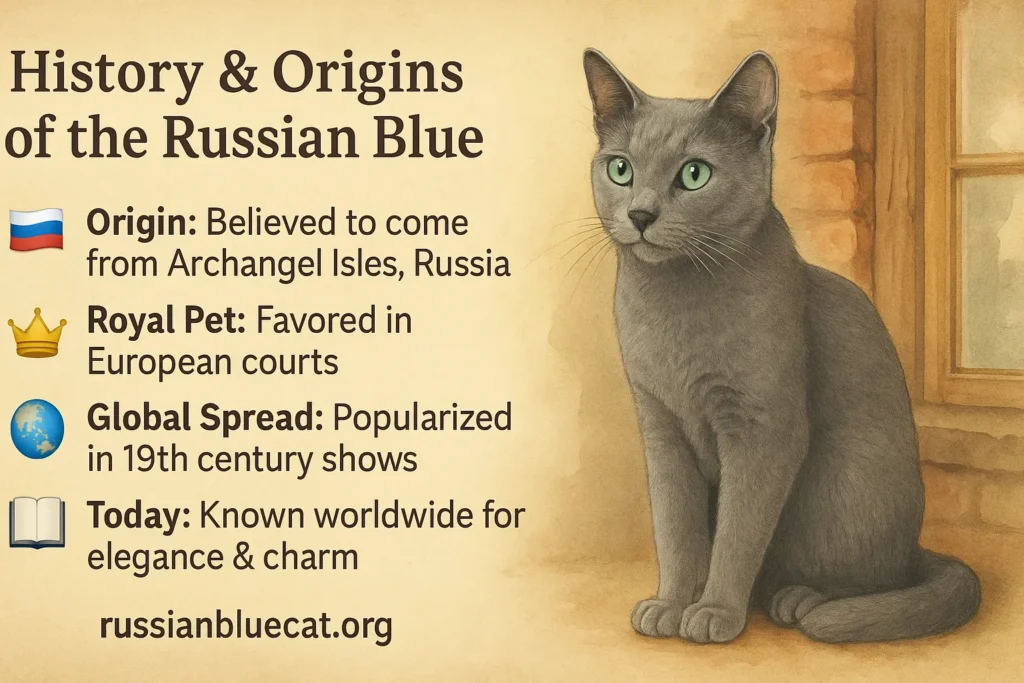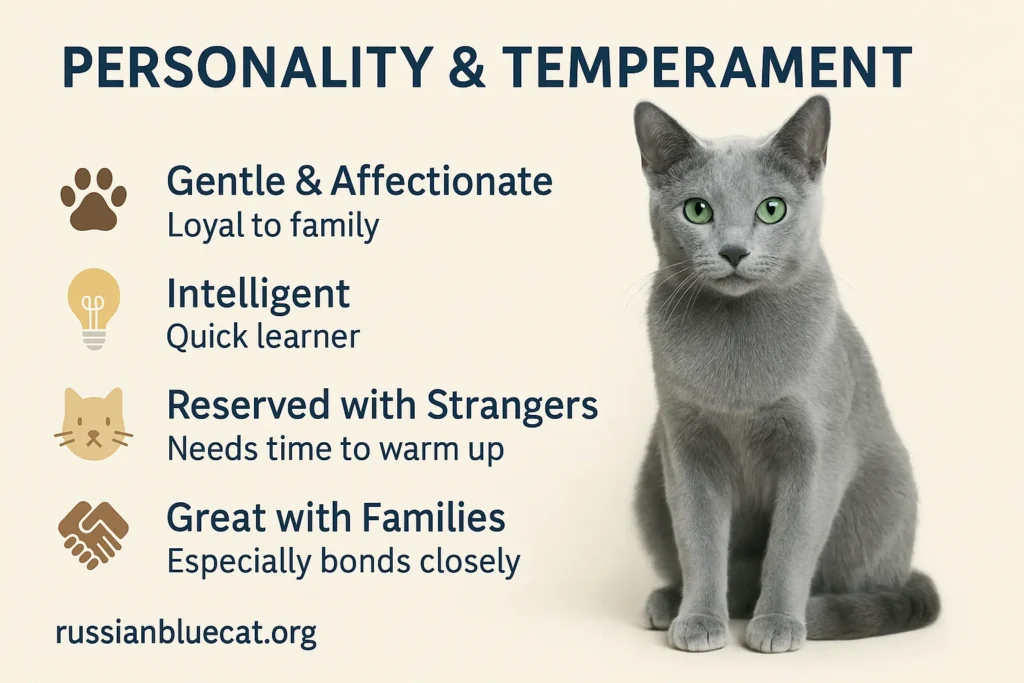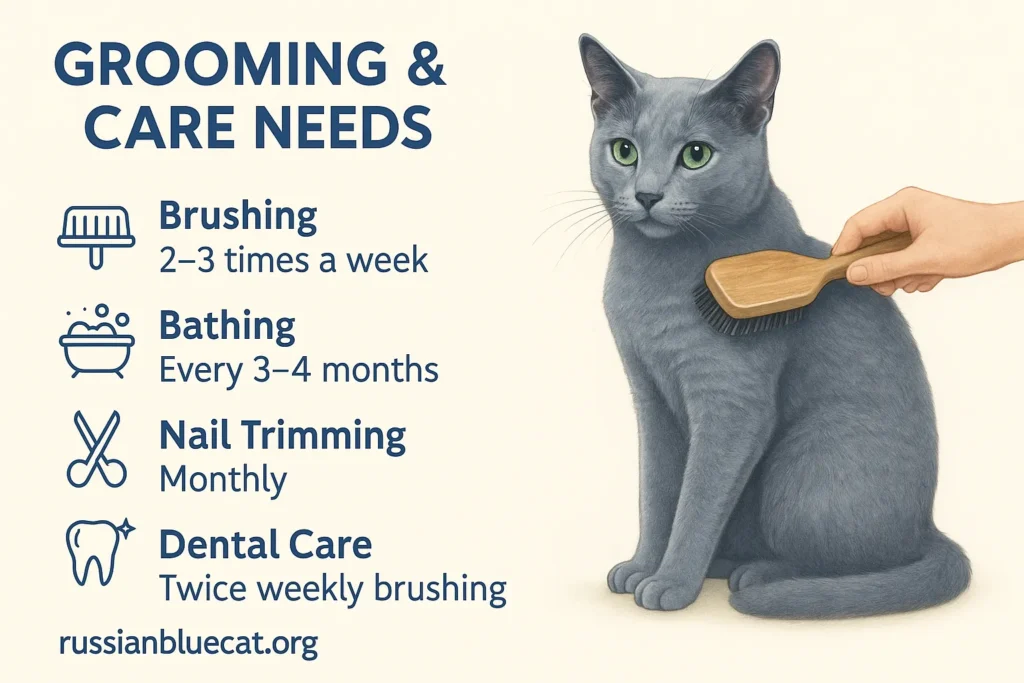10 Mind-Blowing Russian Blue Cat Facts Every Owner Should Know in 2025

Introduction
Picture this: entering a warm living room where there rests on the windowsill a lean cat with a gleaming silver-blue coat. Its bright emerald eyes fix you intently with consciousness, and as you sit down, it politely jumps alongside you, curling up like a devoted friend. That is the charm of the Russian Blue.
This article delves into the most interesting Russian Blue Cat Facts, providing you with a complete guide to this remarkable breed. From their enigmatic past to their loving nature, from grooming to training, and even cultural mythology all you need to know is in one ultimate source.
History and Origins of the Russian Blue Cat

One of the most fascinating Russian Blue Cat Facts is that they are mysterious in origin. It is thought that the breed originated in Arkhangelsk, a north Russian port town. Sailors had them on board ships during the 1800s, distributing them throughout Europe. Their original name, “Archangel Cats,” shows both where they came from and their angelic appearance.
Their first official outing was at the Crystal Palace Cat Show in London in 1875, and viewers were wowed by their radiant blue coats. But their survival wasn’t always guaranteed. World War II came close to wiping them out, and the breeders resorted to cross-breeding them with Siamese and Bluepoint cats to keep the line going. By careful rebuilding, today’s Russian Blues have ensured their recognisable appearance and temperament.
Myth and Folklore: Russian folklore has typically depicted them as charms to good fortune, said to repel evil spirits and bring prosperity into homes.
Physical Attributes of the Russian Blue
The Legendary Coat
One of the most well-known Russian Blue Cat Facts is their coat. Their individual hairs are tipped with silver, which gives them a shining appearance. Their coat is double-layered: dense and plush undercoat, outer coat silky and soft. Their fur stands almost erect, unlike other cats, which makes them look full and fluffy.
Eyes That Tell Stories
Russian Blue kittens have yellowish eyes at birth, but by adulthood, they become their iconic emerald green stare. The change is gradual and hypnotic, evoking maturity.
Build and Size
They are a medium build, with males weighing between 10–12 pounds and females between 7–10 pounds. They’re lean but muscular, with long legs that provide them with an elegant gait. Their wedge-head, high cheekbones, and wide forehead contribute to their noble features.
Personality and Temperament

Intelligent and Curious
Probably the most fascinating Russian Blue Cat Fact is how intelligent they are. Owners usually comment on their Russian Blues learning how to open doors, solving puzzle toys, and even playing fetch.
Loyal but Reserved
They love their family but tend to be reserved around new people. Visitors might catch a glimpse of blue fur as the cat hides until everyone has gone out of sight.
Lovers of Routine
Russian Blues love routine. They like regular meals, routine surroundings, and ordinary routines. Stress may be caused by change, so stability is essential.
Quiet Companions
Russian Blues are quiet compared to loud breeds such as the Siamese. Their meows are soft and used sparingly, and so they are well suited to a quiet home.
Grooming and Care

Coat Maintenance
Another interesting Russian Blue Cat Fact: in spite of their soft coat, they are low maintenance. Brushing once a week is typically sufficient to maintain their shiny coat and control shedding. More frequent brushing will be necessary during spring and autumn shedding seasons. Check our detailed guide on Russian Blue Cat grooming.
Nail, Ear, and Dental Care
Nails need to be trimmed every 2–3 weeks. Ears may be cleaned monthly with a solution recommended by a veterinarian. Brushing teeth 2–3 times per week prevents gum disease.
Bathing
Bathing is rarely necessary. These cats are excellent self-groomers. A bath every few months or only if they get into something messy is plenty.
Health and Lifespan

Longevity
One of the most reassuring Russian Blue Cat Facts is their long lifespan. With proper care, they often live between 15–20 years, and many owners report cats living even longer. Check our detailed guide on Russian Blue Cat Lifespan
Common Concerns
- Obesity: Russian Blues adore food, so portion control is critical.
- Dental Problems: Gum disease is prevalent with no dental care.
- Genetic Health: They are comparatively healthy with breed-specific ailments but need periodic vet check-ups.
Preventive Care
Regular vaccinations, annual checkups, and proper diet will keep your Russian Blue healthy.
Diet and Nutrition
Feeding Guidelines
Quality cat food with protein being the primary ingredient is paramount. As Russian Blues have a tendency to overeat, it’s advisable to feed portioned meals twice a day rather than free-feeding.
Treats and Moderation
Treats cannot be more than 10% of total daily calories. Dental treats serve to maintain oral health while also serving as enrichment.
Hydration
Wet food is a good idea as it enhances hydration, maintaining urinary and kidney function. Always give fresh water.
Training Russian Blue Cats
Yes, Russian Blues are trainable — another great Russian Blue Cat Fact. Their loyalty and intelligence make them ideal prospects for training.
Litter Box Training
The majority of Russian Blues acclimate easily, but kittens might require training. Putting them in the litter box after meals inculcates the habit.
Scratching Post Habits
They instinctively scratch, so providing scratching posts is essential. Spraying with catnip or redirecting them tactfully reinforces this habit.
Command Training
Russian Blues can be trained to heed commands such as “sit,” “come,” and even fetch. Brief, positive training sessions with treats are best.
Harness Training
Russian Blues love outdoor escapades on a leash. Begin short sessions in the house first and then transition outside to secure areas.
Russian Blue Lifelong Companions
Family Friendly Companions
They are kind to children who respect their personal space. Their patience makes them great family companions.
Ideal for Singles or Seniors
Russian Blues offer comfort and companionship for singles. Seniors enjoy their relaxed demeanor and low-maintenance lifestyle.
With Other Pets
Russian Blues get along perfectly with other cats and dogs if introduced correctly.
Interesting and Quirky Russian Blue Cat Facts

- Hypoallergenic Traits: They secrete fewer of the Fel d 1 protein, which is a relief for allergy patients.
- Fortune Charms: In Russian mythology, they bring wealth and protect against evil.
- Routine Loving: They don’t like to have their routine changed suddenly.
- Velcro Cats: They tend to attach themselves to an individual person and stay glued to them.
- Soft Voices: They hardly ever meow loudly.
- Cultural Icons: Appearing in books, films, and even royal residences.
- Emotional Sensitivity: They soothe owners during stressful periods.
- Agile Hunters: Their lean body is a natural hunter.
- Long Lives: Most live well over 18 years.
- Art and Literature: Russian Blues feature in paintings and literature across Europe.
Pros and Cons of Having a Russian Blue Cat
Russian Blue FAQs
Conclusion
The lengthy list of Russian Blue Cat Facts presents an image of a breed that is lovely, smart, loving, and rich in tradition. They are elegance, mystery, and devotion cats. Having one is accepting a routine-oriented, devoted companion who will be by your side for almost two decades.
From their origins in Russia to their presence in modern homes worldwide, Russian Blues remain among the most captivating breeds. Whether you’re adopting one or simply admiring their beauty, understanding these facts ensures a deeper appreciation of this extraordinary feline.






